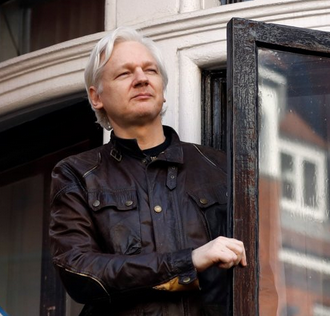While under house arrest in England in 2011, WikiLeaks founder Julian Assange granted an exclusive interview to El Faro’s founding director Carlos Dada and expressed hope that the leaked cables would help set a higher bar for global journalism. The organization then offloaded hundreds of thousands of U.S. government documents to local outlets around the world, including El Faro.
By El Faro
HAVANA TIMES – A decade ago, the controversial WikiLeaks offered an unprecedented window into the workings of the U.S. government in Central America. Now the possible extradition and trial of founder Julian Assange may set a dangerous precedent for the criminalization of commonplace news-gathering activities, press advocates say, and contradict moves by Biden to punish those seeking to harm journalists around the world.
“A Wounded Titan”
Over a decade after WikiLeaks shook the world by releasing hundreds of thousands of secret U.S. military documents and diplomatic cables, the U.K. is on the brink of extraditing the nonprofit’s embattled and enigmatic Australian founder, Julian Assange, into the hands of the U.S. justice system.
The Justice Dept., which in 2020 called the hacks “one of the largest compromises of classified information in the history of the United States,” is pressing charges including conspiracy to hack U.S. government servers and the publication of national defense information received from third parties and whistleblowers including then-U.S. soldier Chelsea Manning.
Assange has staved off extradition for over two years in a U.K. prison since the Ecuadorian Embassy in London revoked his asylum protections. As world leaders convened at Biden’s Summit for Democracy on Dec. 10, a London judge ruled to extradite Assange, dismissing his attorneys’s argument that his removal to the U.S. and conditions of confinement would push him to suicide. Barring a successful last-minute legal challenge to the extradition, and if convicted under the 1917 Espionage Act, he faces up to 175 years in prison.
“The insistent requests to extradite Assange are a negative message to the sources that have filtered confidential information” essential to the work of investigative journalists around the world, argues Jennifer Ávila, co-founder and director of independent Honduran outlet Contracorriente. “It’s a message of fear to sources.”
“The attitude of the United States is that of a wounded titan,” says El Faro director Carlos Dada of the Biden administration’s push for extradition. “It’s that of an emperor that feels humiliated and thus reacts in a damaging way.”
The leaks exposed to the world the internal communications of U.S. embassies, messages containing at times withering assessments of the politics of host countries and delicate private talks with host governments. The leaks, often cited as a catalyst of the Arab Spring, also revealed evidence of U.S. war crimes during the occupations of Afghanistan and Iraq.
“We’re changing what people accept as truth,” Assange told El Faro in 2011. Assange called the leaked diplomatic cables “a resource that everyone in the world can refer to, a sort of scaffold to make decisions on, to look at how international relations work, and to look at how the influence of big business on government works.”
While under house arrest in England in 2011, WikiLeaks founder Julian Assange granted an exclusive interview to El Faro’s founding director Carlos Dada.
WikiLeaks released thousands of U.S. cables to Central American newsrooms documenting the nation’s footprint and outlook on the isthmus. El Faro revealed, for example, left-wing former Salvadoran president Mauricio Funes’ 2009 pledge to send Salvadoran troops to Afghanistan — the troops deployed in 2013 — and the U.S. ambassador in Honduras’ fleeting efforts to prevent the 2009 military coup.
“These cables revealed the discussions held about the coup d’état and the role that the U.S. played in this historic event that unleashed an institutional crisis, one that still engulfs us today,” says Ávila.
Nicaragua’s Confidencial revealed, among dozens of other stories, failed U.S. bargaining with the newly-formed Ortega administration in 2008 for the destruction of USSR-made surface-to-air missiles.
“The cables made us see the two different faces of the United States in our countries,” says Dada of WikiLeaks’ impact in Central America. “Obviously, behind its foreign policy were its own interests,” he argues. “They consistently measured their counterparts in our countries based on how much they kept in line with those interests.”
“On the other hand,” he adds, “this will sound paradoxical, but they revealed to us a United States that was genuinely interested in human rights.”
The leaks were just the beginning of WikiLeaks’ skirmishes with the U.S. government. In the run-up to the 2016 U.S. elections, WikiLeaks filtered the communications of presidential candidate Hillary Clinton. A year later, the organization exposed a score of CIA hacking tools, leading Trump Secretary of State Mike Pompeo, the agency’s former director, to brand WikiLeaks a “non-state hostile foreign intelligence service.” In 2017, senior CIA and Trump administration officials allegedly floated options to kidnap or assassinate Assange.
A grand jury indicted Assange in 2019 in absentia for allegedly conspiring with Chelsea Manning to break into a Dept. of Defense computer. Last year U.S. prosecutors broadened the accusations to charge Assange, acting as a publisher, with espionage, “an assertive, unprecedented legal crackdown on the traditional rights and protections for publishers,” commented MSNBC’s chief legal correspondent.
“The new Trump DOJ indictment treats activities most top newspapers engage in — gathering and publishing classified material — as criminal plotting,” he added.
The New York Times editorial board concurred at the time. “The Trump administration has chosen to go well beyond the question of hacking to directly challenge the boundaries of the First Amendment,” it wrote in response to the second indictment, arguing that the Assange case “could have a chilling effect on American journalism as it has been practiced for generations.”
The top editors at The Wall Street Journal, The Washington Post, USA Today, The Guardian, and Le Monde urged the Trump administration to drop the affair, though of the papers only The Guardian has weighed in on the London court’s decision in favor of extradition.
“The U.S. has this week proclaimed itself the beacon of democracy in an increasingly authoritarian world,” wrote the British paper on the day of the ruling. President Biden has regularly argued in favor of a free press and condemned the stances of the Trump administration, and has even specifically created new sanctions to punish governments hostile to journalists, including the murderers of Jamaal Khashoggi. In Central America, the Biden White House has frequently condemned attacks against the press by regional governments.
“If Mr. Biden is serious about protecting the ability of the media to hold governments accountable,” The Guardian continued, “he should begin by dropping the charges brought against Mr. Assange.”
Press freedom advocates argue that the extradition and prosecution of a non-citizen under the 1917 U.S. Espionage Act could set a dangerous precedent. “Every regime now can point to us and say, ‘We want to extradite these journalists.’” said ACLU attorney Ben Wizner.
El Faro has also weighed in. “If Assange is extradited and convicted in the United States for making these documents public, we journalists and newsrooms are all exposed,” wrote the editorial board in 2019 following his arrest.
The Biden administration has refrained from openly commenting on the Assange case since taking office. In February, a coalition of two-dozen U.S.-based press freedom, civil liberties, and human rights organizations signed a joint letter to the Dept. of Justice calling on Biden to back down from extraditing and prosecuting Assange and arguing that the indictment “poses a grave threat to press freedom both in the United States and abroad.”
“Much of the conduct described in the indictment is conduct that journalists engage in routinely,” wrote the coalition. “The Biden administration’s Dept. of Justice now has an opportunity and an obligation to end this dangerous charade.”





:quality(70)/cloudfront-us-east-1.images.arcpublishing.com/mco/7SEHHFUEXVGS3EAUALEA4OHXBA.jpg) A squad of U.S. Navy SEALs participates in special operations urban combat training at an undisclosed location. (Petty Officer 2nd Class Meranda Keller/U.S. Navy via AP)
A squad of U.S. Navy SEALs participates in special operations urban combat training at an undisclosed location. (Petty Officer 2nd Class Meranda Keller/U.S. Navy via AP):quality(70)/cloudfront-us-east-1.images.arcpublishing.com/mco/H7CKATOAMBBQHCLO55IVYF4KFA.jpg)
:quality(70)/cloudfront-us-east-1.images.arcpublishing.com/mco/X6DAXPIZDNEL3EWHMY26FJMFOE.jpg)
:quality(70)/cloudfront-us-east-1.images.arcpublishing.com/mco/V6LUDPAQAFETZGMDBPLOOKG2IQ.jpg)
 i
i



